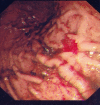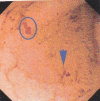Successful treatment of bleeding gastro-intestinal angiodysplasia in hereditary haemorrhagic telangiectasia with thalidomide
- PMID: 22674103
- PMCID: PMC3214210
- DOI: 10.1136/bcr.08.2011.4585
Successful treatment of bleeding gastro-intestinal angiodysplasia in hereditary haemorrhagic telangiectasia with thalidomide
Abstract
Hereditary haemorrhagic telangiectasia (HHT) is an autosomal dominant disorder characterised by epistaxis, cutaneous telangiectasia and visceral arterio-venous malformations (AVMs). It affects approximately one in 5000 people. Control of sustained and repeated haemorrhages from telangiectasias in the nose and gut in patients who may be transfusion dependent is clinically challenging. After repeated endoscopic coagulations, multiple lesions often recur at other sites of gastro-intestinal tract, where endoscopic therapy or surgical resection is not possible. Hormonal therapy has been employed for more than 50 years but has recently been shown to be ineffective. Thalidomide, with its antiangiogenic mechanism of action, seems to be promising drug as a treatment option where other modalities have been unsuccessful. In this article, the authors discuss a novel treatment of bleeding gastro-intestinal angiodysplasia.
Conflict of interest statement
Figures
References
-
- Kjeldsen AD, Vase P, Green A. Hereditary haemorrhagic telangiectasia: a population-based study of prevalence and mortality in Danish patients. J Intern Med 1999;245:31–9 - PubMed
-
- Dakeishi M, Shioya T, Wada Y, et al. Genetic epidemiology of hereditary hemorrhagic telangiectasia in a local community in the northern part of Japan. Hum Mutat 2002;19:140–8 - PubMed
-
- Junquera F, Saperas E, de Torres I, et al. Increased expression of angiogenic factors in human colonic angiodysplasia. Am J Gastroenterol 1999;94:1070–4 - PubMed
Publication types
MeSH terms
Substances
LinkOut - more resources
Full Text Sources
Medical



